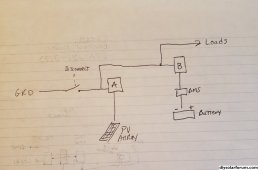When the grid does down, anything attached to the grid has no power.
Sunny Island is a UPS. You connect a battery to it, and battery is charged from the grid AC2 input terminals. If grid goes down, SI disconnects by relay and makes power downstream, AC1 terminal "island" grid. If Sunny Boy is connected to AC1, it's power can also charge battery, and you have an AC coupled offgrid system. When grid is up, SB can backfeed grid, or not, depending on SI configuration (disconnect from grid to prevent backfeed.)
If SB is connected directly to grid wires (same as SI AC2 terminals), it can't supply SI when grid is down. When grid is up, it can supply all loads on the grid side, SI, and all loads on SI AC1 side, also backfeed the grid. If you want zero export, you need a configuration with CT going to a meter, and a controller that commands SB wattage. I don't know the details.
You want SI installed upstream of SB. That makes a grid-backup system that runs indefinitely. If loads are large enough to drain battery, you should run 48V control wires from SI to power relays, thermostat, etc. for load-shed.
SI and these old SB have copper wound low-frequency transformer, so they are isolated from the grid. SMA pioneered transformerless grid-tied inverters and received utility permission for them. Those are the models with "TL" in the part number. Also Sunny Boy Storage battery inverter (but it requires transformer to make 120/240V split phase.)
Ethernet may be 10 Mbit to 100 Mbit on Cat5, with magnetic isolation in RJ-45 jacks. Speedwire is Ethernet, can connect through router to your PC or the web.
You could use Cat5 cable for RS-485. RS-485 may be 1200 baud to 19,200 baud, non-isolated, and SMA equipment defaults to 1200 baud.
2x SI is good to buy. If you were paying $5750 msrp or $4750 street price, you could consider a transformer to make split phase, but with the DC Solar bankruptcy liquidation making these available between $1200 an $2500, buy two. It makes a very capable system. AC coupled with SB, you get available PV watts carrying loads, and 2x SI can then deliver 22kW surge for 240V motor starting (11kW for 120V). SB and SI wattage add together when the sun shines. You can put 24kW of SB on 12kW of SI, if not backfeeding, or 13.4kW SB if backfeeding (relay limit 56A).
Totally offgrid, so they can never find themselves looking into the grid and not performing anti-islanding. To comply with regulations and manufacturer's instructions.
The older SB with RS-485 can switch between UL-1741 (with anti-islanding and grid voltage/frequency limits), and Island (wide limits, no anti-islanding.) That is called Backup. According to documentation, you're supposed to use Backup mode for SB that is downstream of SI, when SI is fed by grid. Other brand GT PV, and newer SB without Backup, you're supposed to use Rule-21 (has anti-island, frequency-watts, and slightly wider voltage limits.)
It does function just fine under normal circumstances to configure any SB for Island and use downstream of SI for grid-backup. SMA support told me to do that after I bought SB 10000TL-US-12 and discovered Backup failed to implement frequency-watts. I saw a video from SMA America saying to put SB -41 in Island mode for systems like that. Yet written instructions from SMA Germany said not to. I suspect it is due to FMEA, they realized that if relay in SI welded shut, they would have GT PV inverter stuck on the grid and not performing anti-islanding. We do hear of these relays welding. I would guess SI can tell when relay is stuck, and would therefore not tell SB to switch from UL-1741 to Island. I was not comfortable with it so I took down my 10000TL-US and replaced them with SB 5000US, which do have a correct Backup mode.






